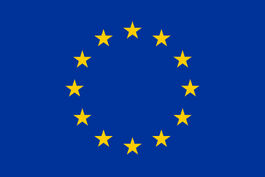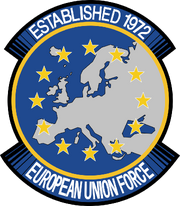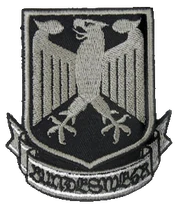
Typhoons participating in a raiding operation against a BETA herd.

Flag of EU
The European Union is a supranational union of various European states. As a unifying force on the European continent, the European Union, called in short the EU.
Enables the different states of the continent to work towards a common goal. in 2019, EU becomes European Federation
History[]
The origins of the EU first started off as the European Community, at that time a loose alliance of West European nations. When the BETA were discovered, and the threat they posed revealed by the speed of their advance, the European Community was expanded into the European Union, a decision made on the assumption that a unified front would allow them to better resist the impending invasion.[1]

Badge of the current European Union Force.
Initially a military alliance, the EU's system was modified to become a quasi-federal system when the devastation caused by the BETA War continued to increase.[1] The solidification of the European Union into a political entity of its own right allowed the continental evacuation and refugee movement of Europe in the '80s to proceed smoothly, compared to that of Asia's,[1] and also made it easier to direct forces in the defence of the European continent.
After the retreat of the Soviets resulted in the loss of their influence on the Eastern European countries that were part of the Warsaw Pact, the remaining nations formed the Eastern European Socialist Alliance. With their fall after the BETA overran large portions of Eastern Europe, the EU also took them in and integrated them into their forces.[2] This action was extended to other non-EU member nations as well, such as Switzerland.[3]
Despite their efforts, and the extensive use of river areas as defence lines, the nations of the EU were unable to stem the tide;[4] following the fall of the Oder-Neisse Defense Line, and subsequently Berlin, in 1983, the BETA continued their push towards the western shores of Europe, expanding northwards via the Alps, through Belgium, towards the English Channel and the United Kingdom, as well as southwards, into the Iberian Peninsula, where Spain and Portugal were located at.[4] The EU faced its largest threat in 1985 with a series of major events, including the Defence of Paris, the Retreat from Dunkirk, culminating in the Defence of Britain, when the BETA attempted large-scale invasion of the England landmass, destroying much of England's southern coasts. Moving all the way inland into southern London, it took six months of fierce fighting to finally dislodge the BETA from their foothold on the English Channel.[4]
The attack was repelled by all nations of the EU and the US military, but the loss in manpower and equipment was almost too crippling to bear for the European nations; were the BETA to follow through with a second strike of that magnitude again, the European Union Force would be unable to stop them. In order to begin a long-term plan to rebuilt their military forces, the EU nations adopted the strategy of "culling operations", making incursions into BETA-held territory to reduce their numbers, in the hopes of delaying an assault or softening an incoming incursion so as to deal with it more easily, and allow the EU to regain its fighting strength.
In addition, a strategic withdrawal of the EU's fighting strength from the Scandinavian Peninsula and the Italian Peninsula to the Mediterranean Sea and the United Kingdom was carried out in 1994, and their forces were massed at coastal areas; both to prevent a transoceanic BETA invasion of their bases around the European continent, and to prepare for the joint recapture of the European mainland in the near future.[5]
Unlike the USA, the European Union supports the continued development of TSFs, and takes a clear anti-usage stance on non-conventional technology; examples include the espers of Alternative III, and the usage of certain types of G-Element-derived weaponry against the BETA. The European Union Force is heavily involved on the Western Defence Line, and frequently carries out culling operations near the English Channel, and around Sicily and the Straits of Gibraltar to prevent the BETA from invading Africa.[5]
Alternative[]
Most of their units participated in the diversionary attack during Operation Ouka. Following the success of the attack on the Kashgar Hive, the European Union began to make preparations for their campaign to retake the European continent, which was finally put into motion in 2004.
Unlimited/The Day After[]
The destruction of the European continent has dealt great damage to the EU, with only France retaining any semblance of a nation; the status of the rest of the countries that make up the European Union are unknown. As of 23rd of February, 2004, most of their land is now submerged underwater following the G-bombing of the Hives around the defence lines on the continent.
Organization[]
Following the loss of European landmass to the BETA, most of the governments and social services of the European nations have been relocated to other locations around the world. The Federal Republic of Germany and Democratic German Republic have their governments housed in Central America, South America, and South Africa;[6] other nations of the European Union have stationed most of their key facilities in Greenland.
While each nation of the EU retains its own military force, anti-BETA operations often involve armies from different countries, necessitating a unified command. Although ostensibly part of the United Nations, soldiers under the command of the European Union wear the badge of the European Union Force.
Dominated by the British, West German, and French armies, as of the year 2000 it is primarily based in Great Britain due to the loss of the European mainland to the BETA, with its headquarters in Belfast, Northern Ireland, and apart from their normal operations, are also involved with refugee support activities with the UN and USA.[1] The EU Force also works closely with non-member nations, such as the military forces of Switzerland and Turkey, and with the Scandinavian nations' efforts in TSF development, in their efforts to keep the BETA contained, and to one day reclaim the European continent.[3]
The current emblem, introduced in 1980, has 12 stars not to symbolize signatory countries, but rather the "perfection and completeness" of the European region.
Armed Forces[]
The European Union's armed forces consist of the militaries of each nation in the Union. Inter-nation joint operations are given great emphasis, and deployment rates are high due to regular BETA-culling operations as part of the the European Union's long-term plan to retake the continent. Forward bases have also been constructed on the various islands in the Mediterranean Sea and the North Sea, to help enforce the continental blockade against the BETA.[3]
The European Union Force also operates alongside the Second Marine Expeditionary Force of the US Navy/US Marine Corps in combat operations, and the personnel of both forces have built up a great degree of respect for each other throughout the years.
Deutsch-Französische Brigade[]
The brigade is one such example of the joint-operation nature of the European Union, and uses troops from both Germany and France in strike operations against the BETA.[7] Formed in 1992 as a joint-force effort to avoid the politics present during Operation Palaiologos, the current Deutsch-Französische Brigade is staffed by the permanent presence of a Lorraine Regiment, representing Germany, and an Alsace Regiment, representing French. The entire unit is under the command of the EU, and answers only to the European Union Force.[7]
While the numbers and force organization in the Brigade may fluctuate and change, it retains its designation of Brigade out of respect for its founder. The names of the permanent regiments under its command take from the territory of Alsace-Lorraine.[7]
Federal Republic of Germany[]
Also known as West Germany, the Federal Republic of Germany is a democratic nation, in contrast to their communist counterpart, East Germany. After the fall of Berlin in 1983, their armed forces, the Bundeswehr, were integrated into the European Union, and the United Nations Force European Region Army command as the West German 1st Tactical Armoured Force.[8]
In recent times, both East and West Germany are in an alliance similar to that of the Unified Front of China.[9]
Bundeswehr[]
Combining the previously-separated branches of the Heer, Marine, and Luftwaffe, the current Bundeswehr (translating to "Federal Defence Force") is

Bundeswehr symbol.
stationed in England, Great Britain, while the government and national structure have been relocated to Central America, South America, and South Africa. Initially operating the F-5 Freedom Fighter and Tornado IDS prior to the 1990s, their current force inventory has expanded to include the EF-2000 Typhoon, with additional F-16 Fighting Falcons and A-10C Thunderbolt IIs on loan from the US military, as well as Tornado ADVs provided by the United Kingdom.[6]
With the great wealth of experience veterans of the Bundeswehr have accumulated over the years, units of the armed forces of West Germany are recognized as some of the most elite forces in the European Union.[6]
- A battalion that was active during the 1980s, led by Major Joachim Balck. They operate the F-5 Freedom Fighter and the F-5G Tornado IDS, and are known to have participated in Operation Neptune. 2nd Lieutenant Kirke Steinhoff is one of their pilots.
- A combat battalion operating the EF-2000 Typhoon, well-known amongst the European Union as one of the best units in the region. As a special-forces squadron, they take on a large variety of missions.
- 109th Independent TSA Squadron Kanonendoktor
- A combat squadron operating A-10C Thunderbolt IIs, callsign Doctor. During the summer of 2000, they were involved in culling operations at Lower Saxony, Germany, and acted as rearguard units for retreating forces, working in tandem with the JA44 Zerberus.
French Republic[]
The Federal Republic of Germany's situation applies to the French as well, although their integration into UN command is not as extensive. Having lost their nation, French armed forces commonly operate in the West Europe region and at the Suez Canal helping to hold the African Defence Line.
But it is possible that this country will survive independently and keep its great power status thanks to its different overseas regions and departments such as French Guyana, Martinique, Guadeloupe and Réunion and New Caledonia, Polynesia Mayotte which allows it to move most of its population and its strategic industries.
The French have a troubled history with the rest of Europe due to differing strategic views. They were opposed to the massive counteroffensive of Operation Palaiologos, believing that force preservation took precedence over an offensive push that put the entire European continent at stake,[7] and pulled out of the ECTSF program due to disagreements concerning the usage of French-production engines in the EF-2000's Jump Units.
Currently, both the French and West German armies also provide troops for the Deutsch-Franzosische Brigade, a joint-operation force organized by both countries.
Sixth French Republic[]
In The Day After universe, in the aftermath of Operation Babylon and the sinking of the Eurasian and African continents, France is forced to escape Europe and settled in Quebec, Canada. There, right-wing radicals in the government quickly gained traction in their hate-fuelled speeches against the atrocity the US had committed against the world through the use of mass G-bombs and, with the support of various political and military officials, organized the newly founded Sixth French Republic, ratifying a new constitution and uniting their people against their new enemy: the United States of America.
Among the supporters of the Sixth Republic was Lea Gegranne, a Major in the French army and commanding officer of the 13th Tactical Dragoons, who proposed and led the operation to capture NORAD.
- French Army 13th Tactical Dragoon Regiment
- French Foreign Legion
United Kingdom[]
As the last remaining intact nation of the European Union, the UK serves as the headquarters of the armed forces of the EU, UN, and US troops stationed on the Euro Front. Having bore the brunt of the fighting in the 1985 Defence of Britain, the UK has realized both the importance of a unified front, as well as proper modern weapons and tactics.[10] To date, the UK is one of the more well-equipped forces of the EU, with a matching navy force that's touted as second only to the US Navy.
The UK currently operates both the EF-2000 Typhoon and F-5E Tornado ADV in frontline combat, and the older F-4 Phantom, bought from the USA as surplus units, for training and defensive troops.[10]
- While not technically part of the United Kingdom nor the European Union's armed forces, the Rain Dancers are still supported by the UK and the multinational Euro Fightas consortium.
- Leaping Jaguars
[]
The naval arm of the UK military, touted as second only to the US Navy. While it is similar to a blue-water navy with numerous cruisers and battleships as its core, their constituent equipment has been updated to primarily focus on the campaign to defend the British mainland, and their main missions are culling operations along the Atlantic-Mediterranean coast.[10]
- Lion-class Battleship
One of the Lion-class ships participated in Operation Neptune.
Italy[]
Currently engaged in a long-term siege with BETA forces on mainland Italy, the Italian armed forces defend the last bastion of their nation, Sicily, from Messina Base.
[]
- 521st Tactical Armored Battalion La Falange di Pirro
- A TSF battalion of the Italian Navy, led by Captain Raphael Benigni. Participated in Operation Bootstrap alongside the Rain Dancers Squadron in 1995.
Spain[]
A member nation of the European Union, they operate the EF-2000, with the Spike Shield being one of their domestic weapons designs. Like West Germany and France, the Spaniards have lost their entire country to the BETA invasion.
Benelux []
A union of three European nations; Belgium, Netherlands, and Luxembourg, the organization also combines the military forces of all three nations, although it is not clear to what extent it does so.
The Netherlands, in particular, was involved in a major holding operation in the Zuiderzee, a shallow bay of the North Sea in the northwest of the Netherlands. The area was later manually flooded to block off the BETA, turning it into a saltwater region; as of 1995, the entire region was in the process of becoming a gigantic salt plain due to geographical changes caused by the BETA, as well as the cessation of fresh river water flowing into the Zuiderzee from the regions within Europe. [11]
- Slechtvalk Flight
- A Project PROMINENCE flight operating four F-16AMs. They were defeated by the Soviet Union's Idol Test Flight during Blue Flag.
References[]
- ↑ 1.0 1.1 1.2 1.3 MLA Euro Front - Duty: LOST ARCADIA, pg. 04, 欧州連合
- ↑ MLA Euro Front - Duty: LOST ARCADIA, pg. 04, 東欧州社会主義同盟.
- ↑ 3.0 3.1 3.2 Integral Works, pg. 232, 欧州連合.
- ↑ 4.0 4.1 4.2 MLA Euro Front - Duty: LOST ARCADIA, pg. 04, 「DUTY -LOST ARCADIA-」 欧州史概説
- ↑ 5.0 5.1 MLA Euro Front - Duty: LOST ARCADIA, pg. 04, 欧州・西欧での間引き作戦
- ↑ 6.0 6.1 6.2 MLA Euro Front - Duty: LOST ARCADIA, pg. 04, 東西ドイツ軍編制.
- ↑ 7.0 7.1 7.2 7.3 MLA Euro Front - Duty: LOST ARCADIA, pg. 04, ドイツ・フランス連合旅団
- ↑ MLA Euro Front - Duty: LOST ARCADIA, pg. 04, 東西ドイツ軍編制, 「西ドイツ陸軍第1戦術機甲軍」.
- ↑ MLA Euro Front - Duty: LOST ARCADIA, pg. 04, 欧州各国概要, 西ドイツ.
- ↑ 10.0 10.1 10.2 MLA Euro Front - Duty: LOST ARCADIA, pg. 04, イギリス
- ↑ MLA Euro Front - Duty: LOST ARCADIA, pg. 04, ゾイデル塩原
| The Euro Front | |||||||
|---|---|---|---|---|---|---|---|
| Releases |
| ||||||
| Characters |
| ||||||
| Setting | |||||||
